four wheel drive TOYOTA TACOMA 2016 Owners Manual (in English)
[x] Cancel search | Manufacturer: TOYOTA, Model Year: 2016, Model line: TACOMA, Model: TOYOTA TACOMA 2016Pages: 640, PDF Size: 40.18 MB
Page 3 of 640
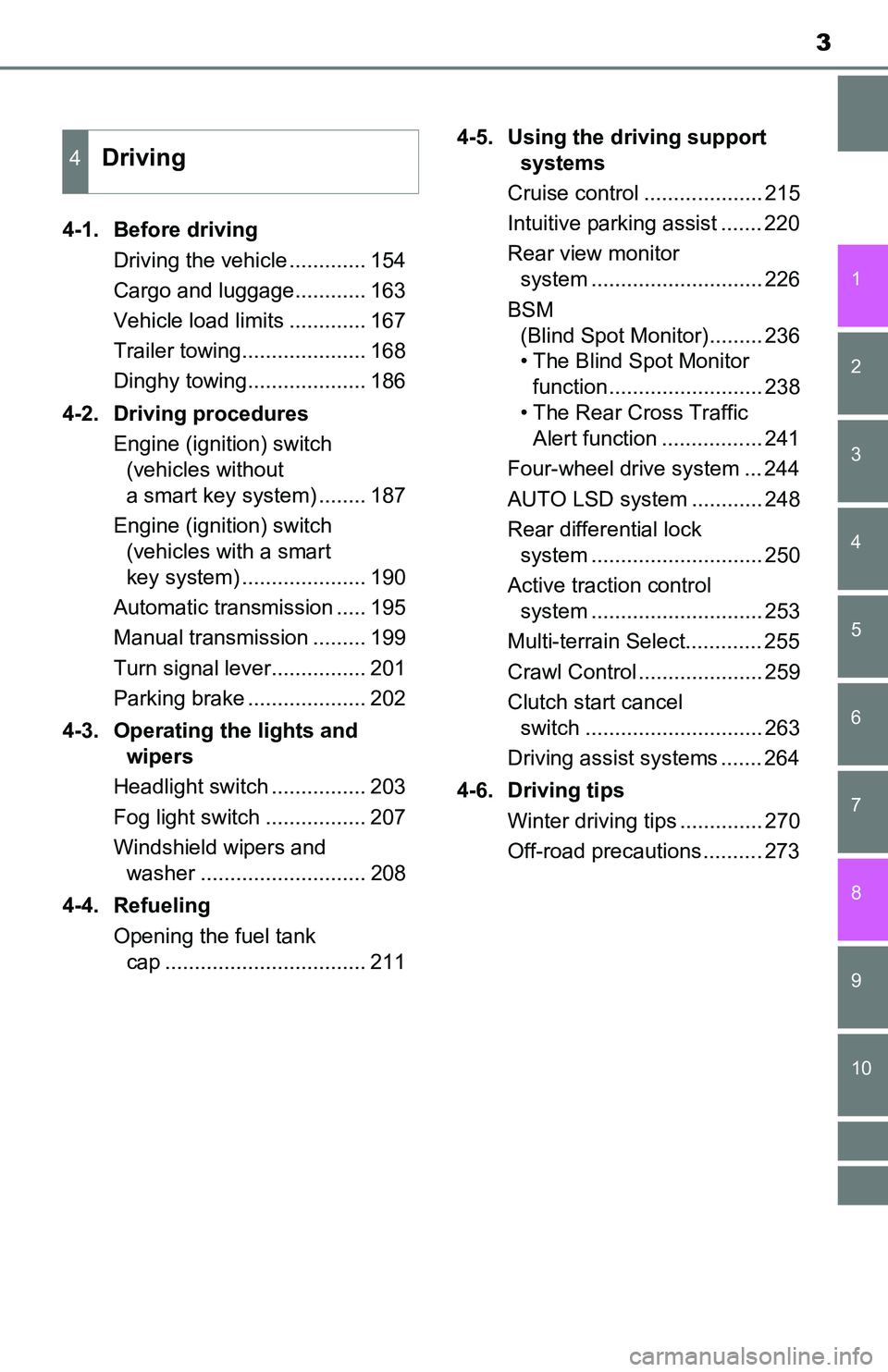
3
1
9 8
7 5 4
3
2
10
6
4-1. Before driving
Driving the vehicle ............. 154
Cargo and luggage............ 163
Vehicle load limits ............. 167
Trailer towing..................... 168
Dinghy towing.................... 186
4-2. Driving procedures
Engine (ignition) switch
(vehicles without
a smart key system) ........ 187
Engine (ignition) switch
(vehicles with a smart
key system) ..................... 190
Automatic transmission ..... 195
Manual transmission ......... 199
Turn signal lever................ 201
Parking brake .................... 202
4-3. Operating the lights and
wipers
Headlight switch ................ 203
Fog light switch ................. 207
Windshield wipers and
washer ............................ 208
4-4. Refueling
Opening the fuel tank
cap .................................. 2114-5. Using the driving support
systems
Cruise control .................... 215
Intuitive parking assist ....... 220
Rear view monitor
system ............................. 226
BSM
(Blind Spot Monitor)......... 236
• The Blind Spot Monitor
function.......................... 238
• The Rear Cross Traffic
Alert function ................. 241
Four-wheel drive system ... 244
AUTO LSD system ............ 248
Rear differential lock
system ............................. 250
Active traction control
system ............................. 253
Multi-terrain Select............. 255
Crawl Control ..................... 259
Clutch start cancel
switch .............................. 263
Driving assist systems ....... 264
4-6. Driving tips
Winter driving tips .............. 270
Off-road precautions .......... 273
4Driving
Page 83 of 640
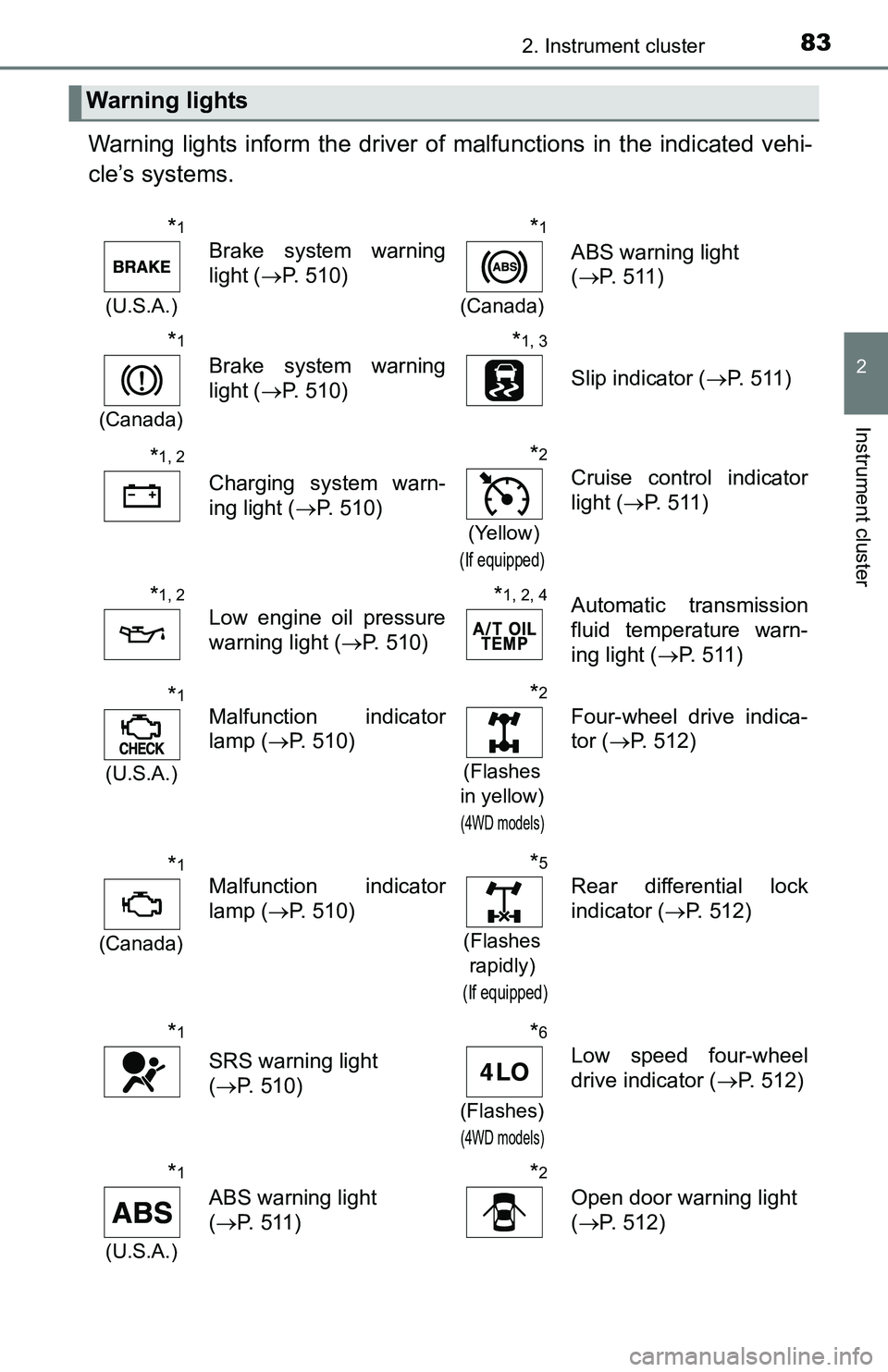
832. Instrument cluster
2
Instrument cluster
Warning lights inform the driver of malfunctions in the indicated vehi-
cle’s systems.
Warning lights
*1
(U.S.A.)
Brake system warning
light (P. 510)
*1
(Canada)
ABS warning light
(P. 511)
*1
(Canada)
Brake system warning
light (P. 510)
*1, 3
Slip indicator (P. 511)
*1, 2
Charging system warn-
ing light (P. 510)
*2
(Yellow)
(If equipped)
Cruise control indicator
light (P. 511)
*1, 2
Low engine oil pressure
warning light (P. 510)*1, 2, 4Automatic transmission
fluid temperature warn-
ing light (P. 511)
*1
(U.S.A.)
Malfunction indicator
lamp (P. 510)
*2
(Flashes
in yellow)
(4WD models)
Four-wheel drive indica-
tor (P. 512)
*1
(Canada)
Malfunction indicator
lamp (P. 510)
*5
(Flashes
rapidly)
(If equipped)
Rear differential lock
indicator (P. 512)
*1
SRS warning light
(P. 510)
*6
(Flashes)
(4WD models)
Low speed four-wheel
drive indicator (P. 512)
*1
(U.S.A.)
ABS warning light
(P. 511)
*2
Open door warning light
(P. 512)
Page 85 of 640
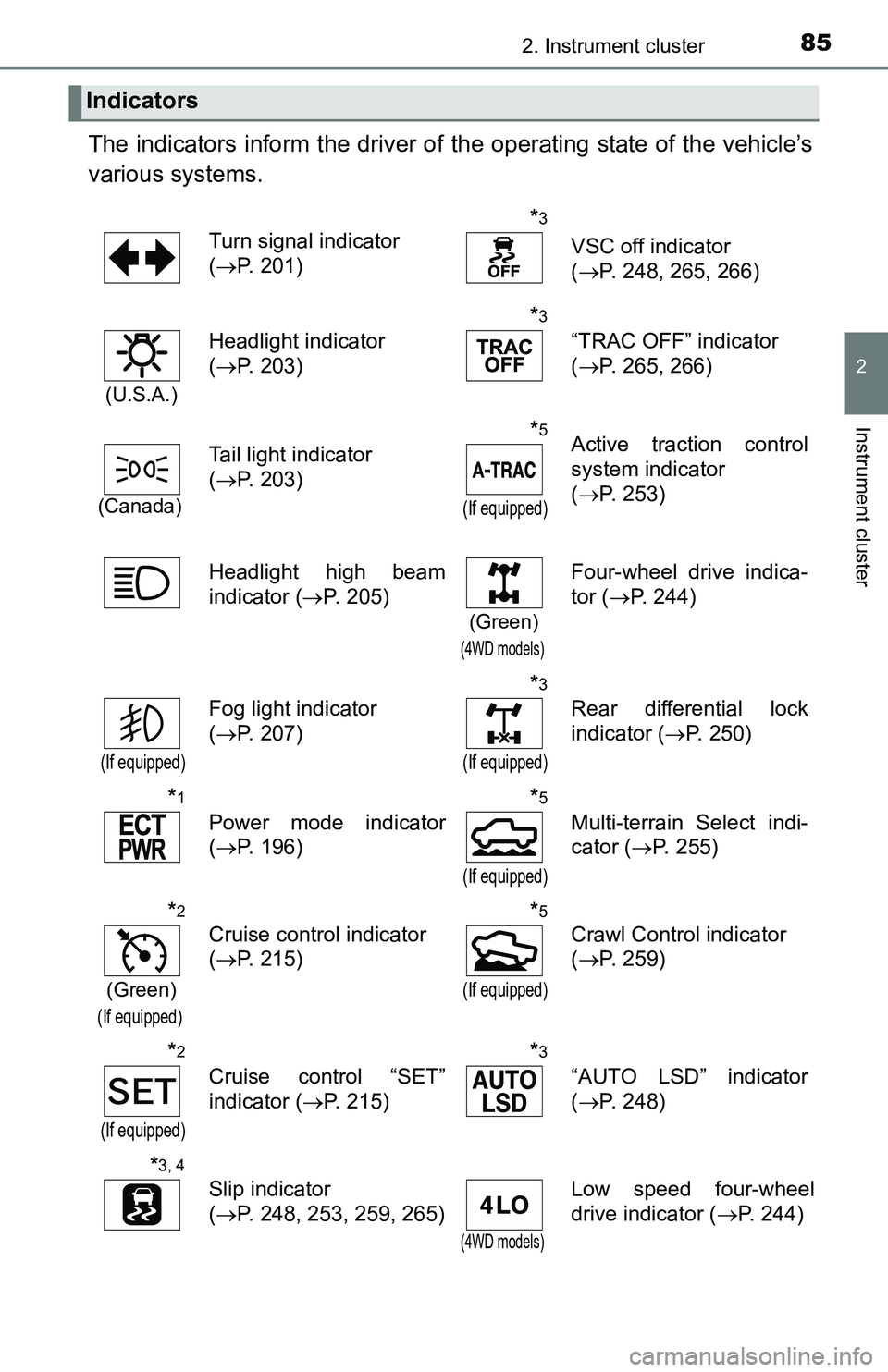
852. Instrument cluster
2
Instrument cluster
The indicators inform the driver of the operating state of the vehicle’s
various systems.
Indicators
Turn signal indicator
(P. 201)*3
VSC off indicator
(P. 248, 265, 266)
(U.S.A.)
Headlight indicator
(P. 203)
*3
“TRAC OFF” indicator
(P. 265, 266)
(Canada)
Tail light indicator
(P. 203)
*5
(If equipped)
Active traction control
system indicator
(P. 253)
Headlight high beam
indicator (P. 205)
(Green)
(4WD models)
Four-wheel drive indica-
tor (P. 244)
(If equipped)
Fog light indicator
(P. 207)
*3
(If equipped)
Rear differential lock
indicator (P. 250)
*1
Power mode indicator
(P. 196)
*5
(If equipped)
Multi-terrain Select indi-
cator (P. 255)
*2
(Green)
(If equipped)
Cruise control indicator
(P. 215)*5
(If equipped)
Crawl Control indicator
(P. 259)
*2
(If equipped)
Cruise control “SET”
indicator (P. 215)
*3
“AUTO LSD” indicator
(P. 248)
*3, 4
Slip indicator
(P. 248, 253, 259, 265)
(4WD models)
Low speed four-wheel
drive indicator (P. 244)
Page 153 of 640
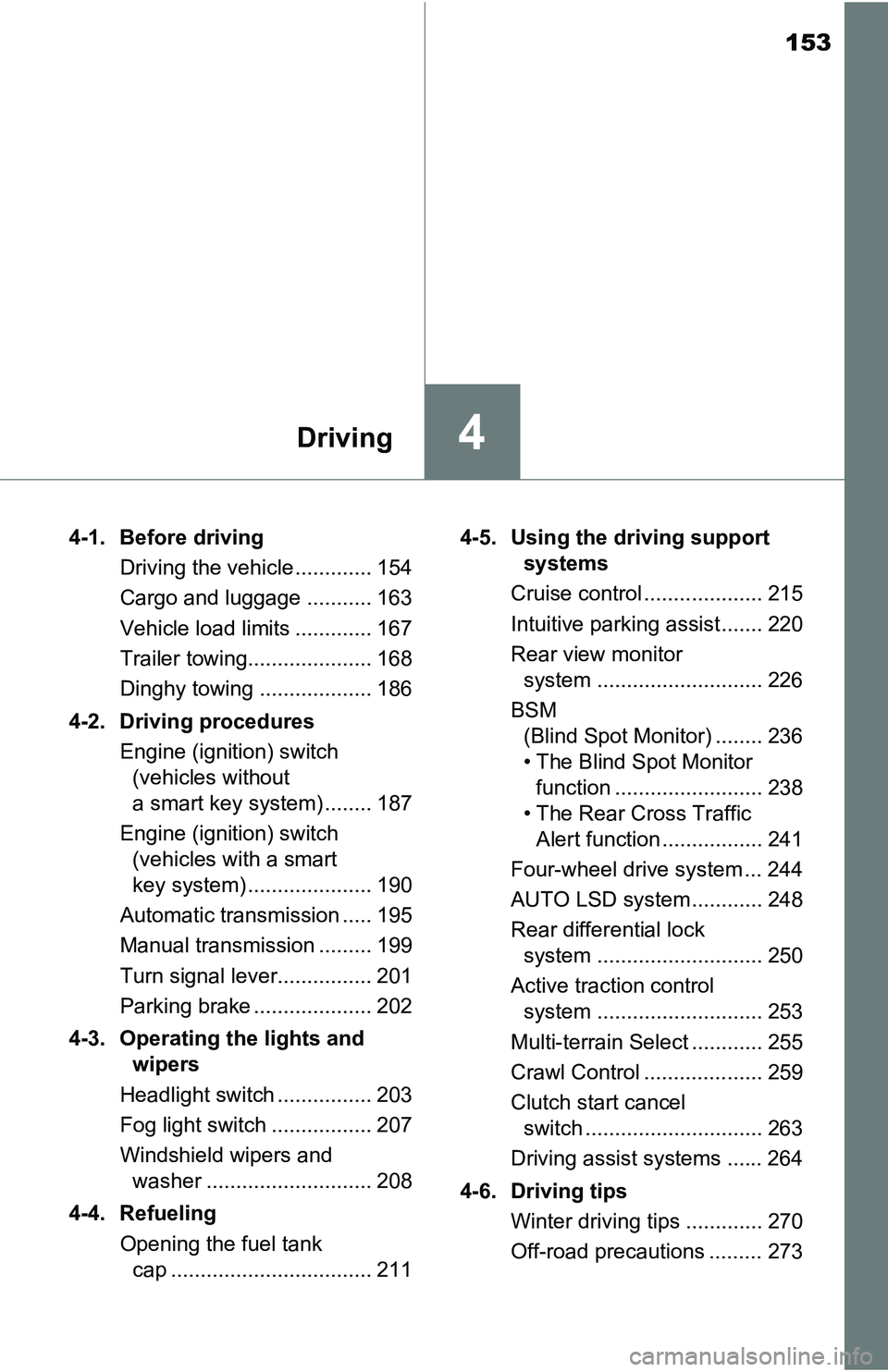
153
4Driving
4-1. Before driving
Driving the vehicle ............. 154
Cargo and luggage ........... 163
Vehicle load limits ............. 167
Trailer towing..................... 168
Dinghy towing ................... 186
4-2. Driving procedures
Engine (ignition) switch
(vehicles without
a smart key system) ........ 187
Engine (ignition) switch
(vehicles with a smart
key system) ..................... 190
Automatic transmission ..... 195
Manual transmission ......... 199
Turn signal lever................ 201
Parking brake .................... 202
4-3. Operating the lights and
wipers
Headlight switch ................ 203
Fog light switch ................. 207
Windshield wipers and
washer ............................ 208
4-4. Refueling
Opening the fuel tank
cap .................................. 2114-5. Using the driving support
systems
Cruise control .................... 215
Intuitive parking assist....... 220
Rear view monitor
system ............................ 226
BSM
(Blind Spot Monitor) ........ 236
• The Blind Spot Monitor
function ......................... 238
• The Rear Cross Traffic
Alert function ................. 241
Four-wheel drive system ... 244
AUTO LSD system............ 248
Rear differential lock
system ............................ 250
Active traction control
system ............................ 253
Multi-terrain Select ............ 255
Crawl Control .................... 259
Clutch start cancel
switch .............................. 263
Driving assist systems ...... 264
4-6. Driving tips
Winter driving tips ............. 270
Off-road precautions ......... 273
Page 244 of 640
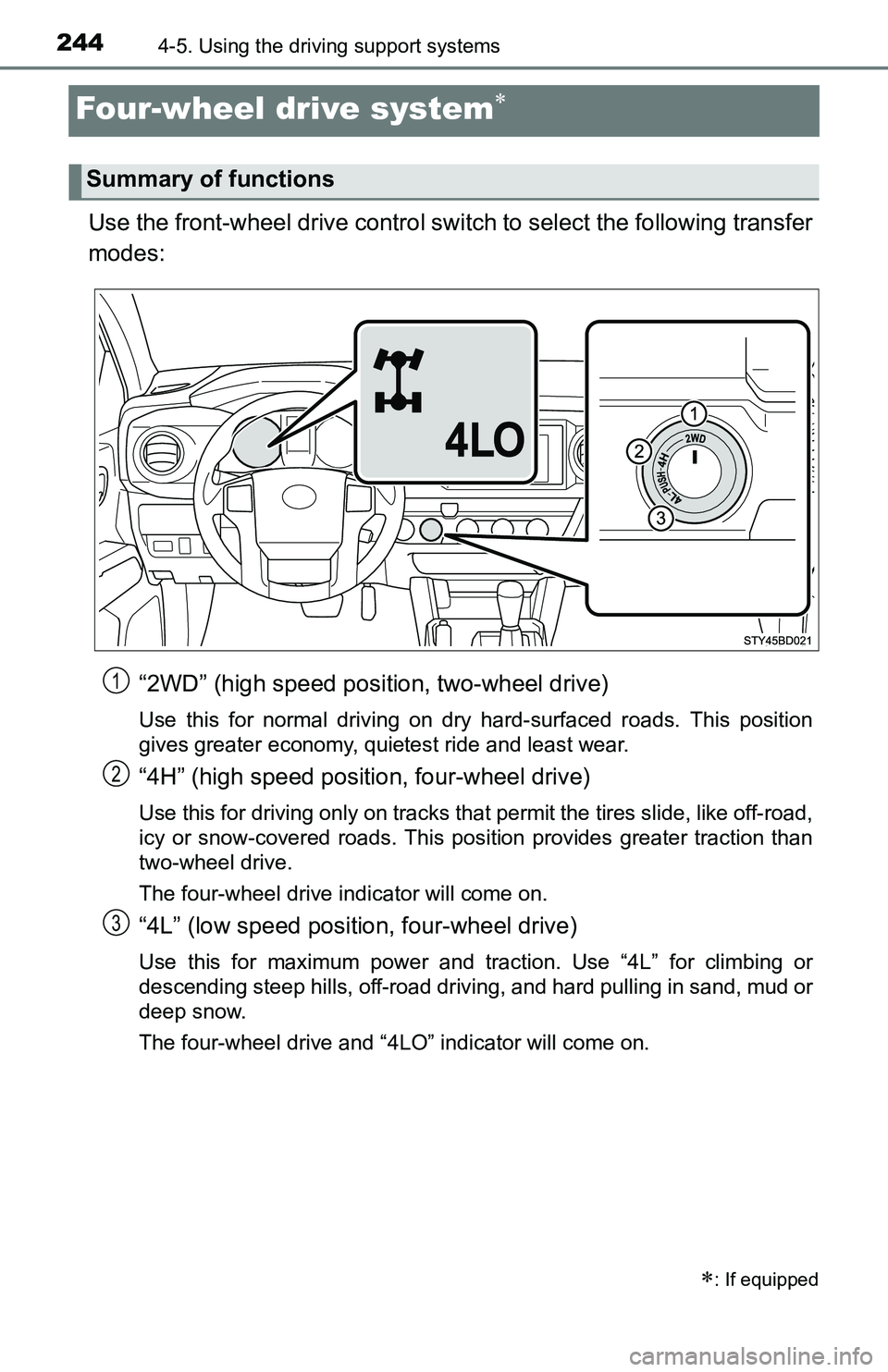
2444-5. Using the driving support systems
Four-wheel drive system
Use the front-wheel drive control switch to select the following transfer
modes:
“2WD” (high speed position, two-wheel drive)
Use this for normal driving on dry hard-surfaced roads. This position
gives greater economy, quietest ride and least wear.
“4H” (high speed position, four-wheel drive)
Use this for driving only on tracks that permit the tires slide, like off-road,
icy or snow-covered roads. This position provides greater traction than
two-wheel drive.
The four-wheel drive indicator will come on.
“4L” (low speed position, four-wheel drive)
Use this for maximum power and traction. Use “4L” for climbing or
descending steep hills, off-road driving, and hard pulling in sand, mud or
deep snow.
The four-wheel drive and “4LO” indicator will come on.
: If equipped
Summary of functions
1
2
3
Page 245 of 640
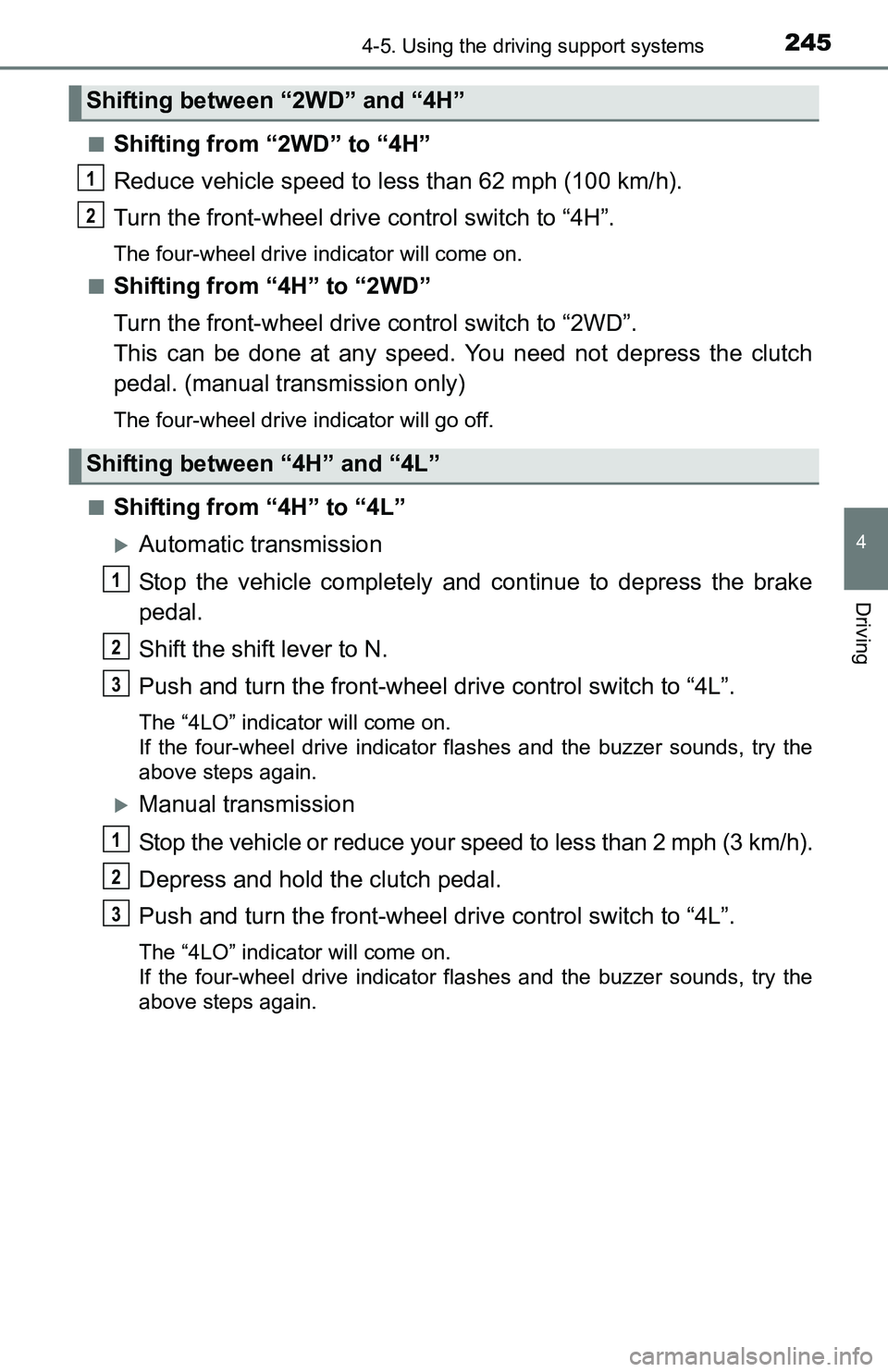
2454-5. Using the driving support systems
4
Driving
■Shifting from “2WD” to “4H”
Reduce vehicle speed to less than 62 mph (100 km/h).
Turn the front-wheel drive control switch to “4H”.
The four-wheel drive indicator will come on.
■
Shifting from “4H” to “2WD”
Turn the front-wheel drive control switch to “2WD”.
This can be done at any speed. You need not depress the clutch
pedal. (manual transmission only)
The four-wheel drive indicator will go off.
■
Shifting from “4H” to “4L”
Automatic transmission
Stop the vehicle completely and continue to depress the brake
pedal.
Shift the shift lever to N.
Push and turn the front-wheel drive control switch to “4L”.
The “4LO” indicator will come on.
If the four-wheel drive indicator flashes and the buzzer sounds, try the
above steps again.
Manual transmission
Stop the vehicle or reduce your speed to less than 2 mph (3 km/h).
Depress and hold the clutch pedal.
Push and turn the front-wheel drive control switch to “4L”.
The “4LO” indicator will come on.
If the four-wheel drive indicator flashes and the buzzer sounds, try the
above steps again.
Shifting between “2WD” and “4H”
Shifting between “4H” and “4L”
1
2
1
2
3
1
2
3
Page 246 of 640
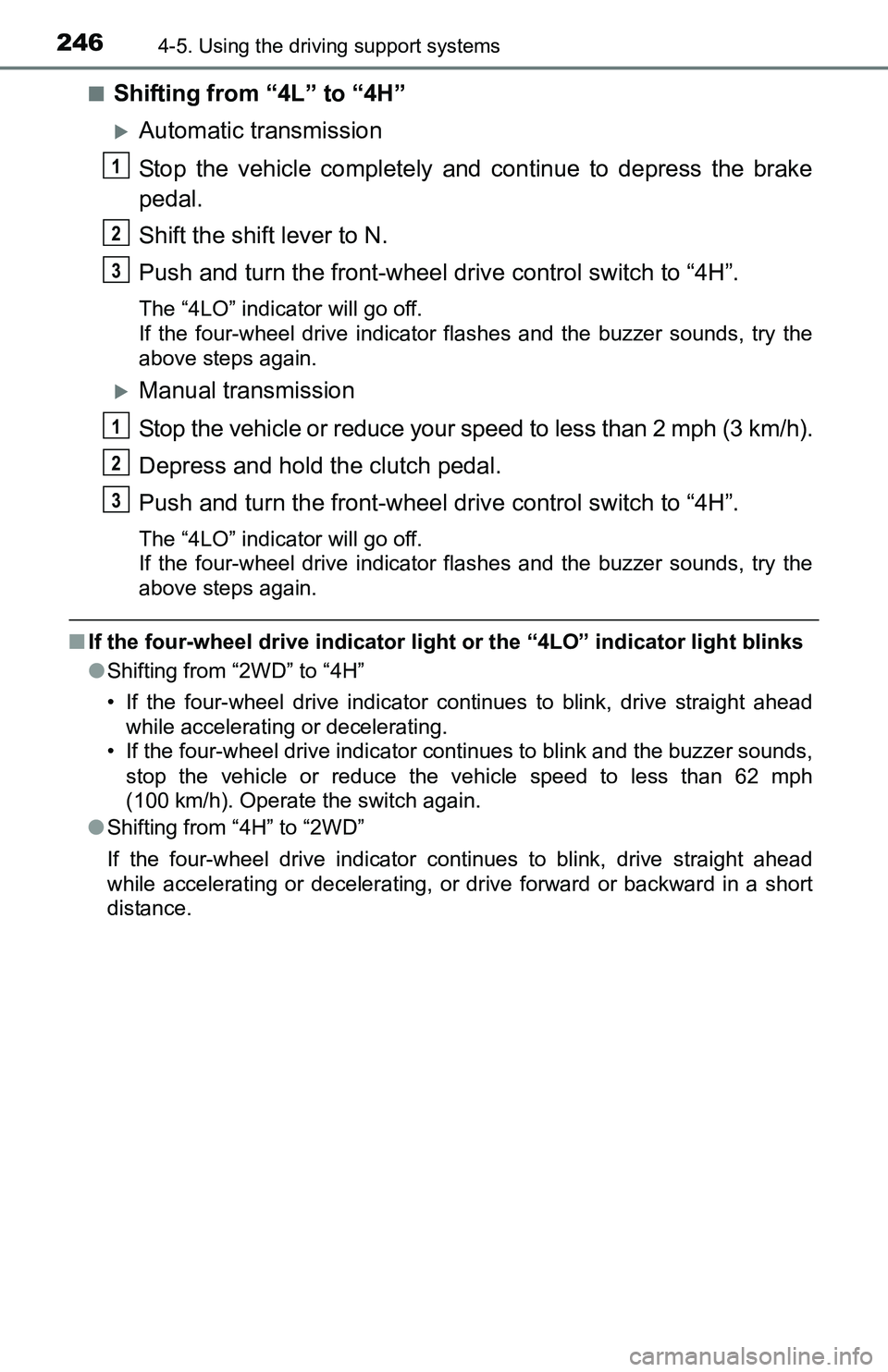
2464-5. Using the driving support systems
■Shifting from “4L” to “4H”
Automatic transmission
Stop the vehicle completely and continue to depress the brake
pedal.
Shift the shift lever to N.
Push and turn the front-wheel drive control switch to “4H”.
The “4LO” indicator will go off.
If the four-wheel drive indicator flashes and the buzzer sounds, try the
above steps again.
Manual transmission
Stop the vehicle or reduce your speed to less than 2 mph (3 km/h).
Depress and hold the clutch pedal.
Push and turn the front-wheel drive control switch to “4H”.
The “4LO” indicator will go off.
If the four-wheel drive indicator flashes and the buzzer sounds, try the
above steps again.
■If the four-wheel drive indicator light or the “4LO” indicator light blinks
●Shifting from “2WD” to “4H”
• If the four-wheel drive indicator continues to blink, drive straight ahead
while accelerating or decelerating.
• If the four-wheel drive indicator continues to blink and the buzzer sounds,
stop the vehicle or reduce the vehicle speed to less than 62 mph
(100 km/h). Operate the switch again.
●Shifting from “4H” to “2WD”
If the four-wheel drive indicator continues to blink, drive straight ahead
while accelerating or decelerating, or drive forward or backward in a short
distance.
1
2
3
1
2
3
Page 247 of 640
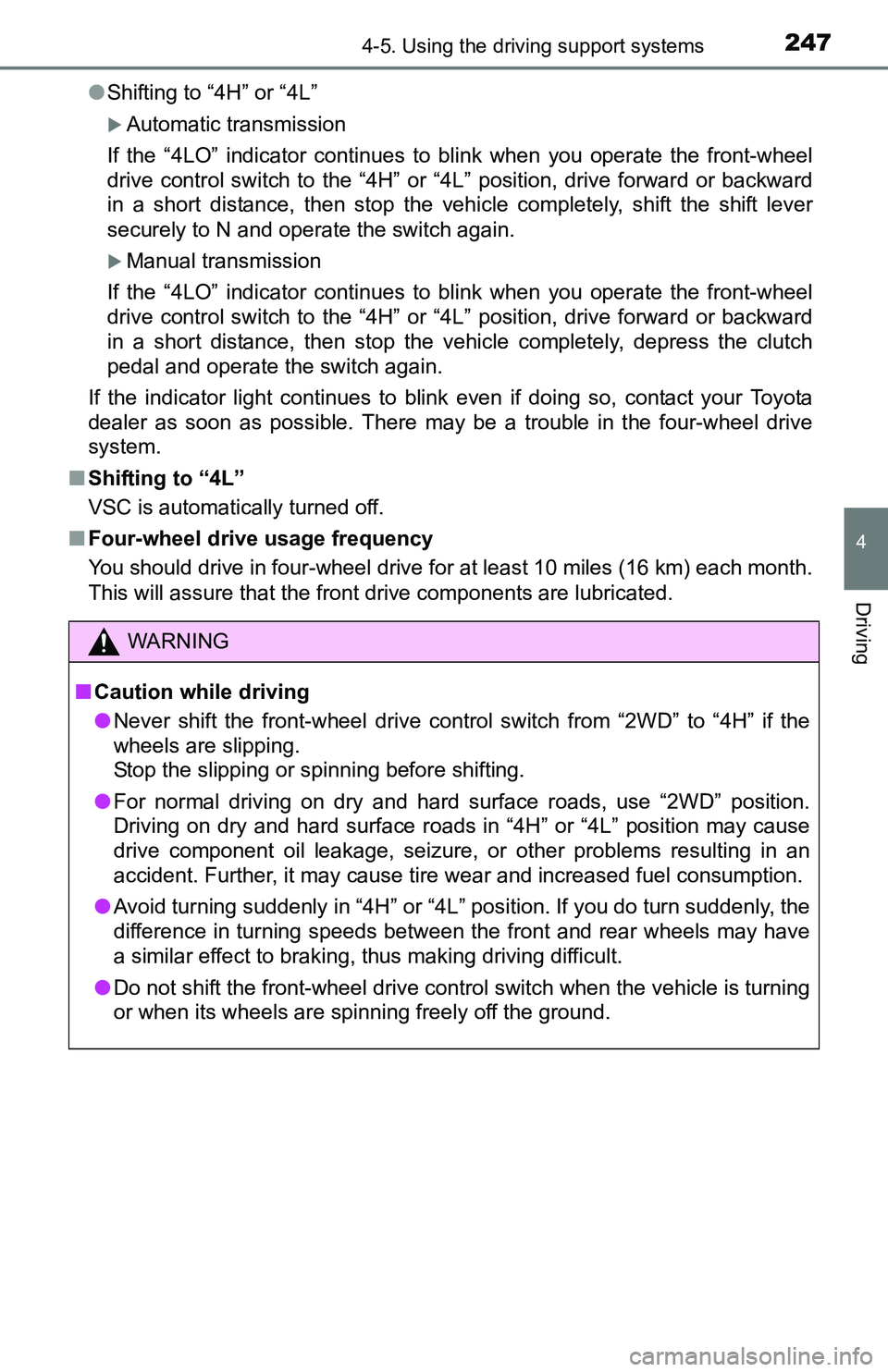
2474-5. Using the driving support systems
4
Driving
●Shifting to “4H” or “4L”
Automatic transmission
If the “4LO” indicator continues to blink when you operate the front-wheel
drive control switch to the “4H” or “4L” position, drive forward or backward
in a short distance, then stop the vehicle completely, shift the shift lever
securely to N and operate the switch again.
Manual transmission
If the “4LO” indicator continues to blink when you operate the front-wheel
drive control switch to the “4H” or “4L” position, drive forward or backward
in a short distance, then stop the vehicle completely, depress the clutch
pedal and operate the switch again.
If the indicator light continues to blink even if doing so, contact your Toyota
dealer as soon as possible. There may be a trouble in the four-wheel drive
system.
■Shifting to “4L”
VSC is automatically turned off.
■Four-wheel drive usage frequency
You should drive in four-wheel drive for at least 10 miles (16 km) each month.
This will assure that the front drive components are lubricated.
WARNING
■Caution while driving
●Never shift the front-wheel drive control switch from “2WD” to “4H” if the
wheels are slipping.
Stop the slipping or spinning before shifting.
●For normal driving on dry and hard surface roads, use “2WD” position.
Driving on dry and hard surface roads in “4H” or “4L” position may cause
drive component oil leakage, seizure, or other problems resulting in an
accident. Further, it may cause tire wear and increased fuel consumption.
●Avoid turning suddenly in “4H” or “4L” position. If you do turn suddenly, the
difference in turning speeds between the front and rear wheels may have
a similar effect to braking, thus making driving difficult.
●Do not shift the front-wheel drive control switch when the vehicle is turning
or when its wheels are spinning freely off the ground.
Page 253 of 640
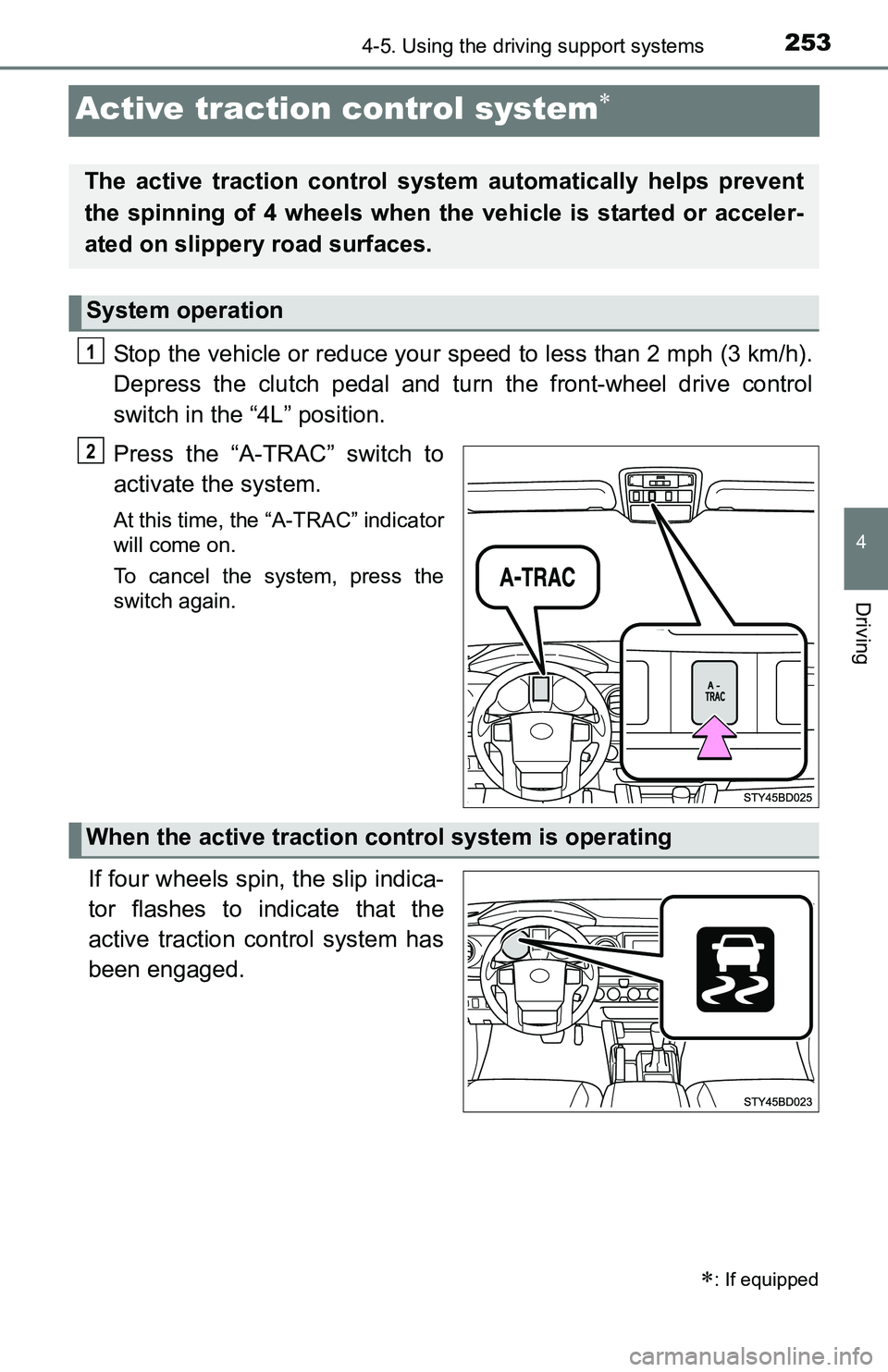
2534-5. Using the driving support systems
4
Driving
Active traction control system
Stop the vehicle or reduce your speed to less than 2 mph (3 km/h).
Depress the clutch pedal and turn the front-wheel drive control
switch in the “4L” position.
Press the “A-TRAC” switch to
activate the system.
At this time, the “A-TRAC” indicator
will come on.
To cancel the system, press the
switch again.
If four wheels spin, the slip indica-
tor flashes to indicate that the
active traction control system has
been engaged.
: If equipped
The active traction control system automatically helps prevent
the spinning of 4 wheels when the vehicle is started or acceler-
ated on slippery road surfaces.
System operation
1
2
When the active traction control system is operating
Page 257 of 640
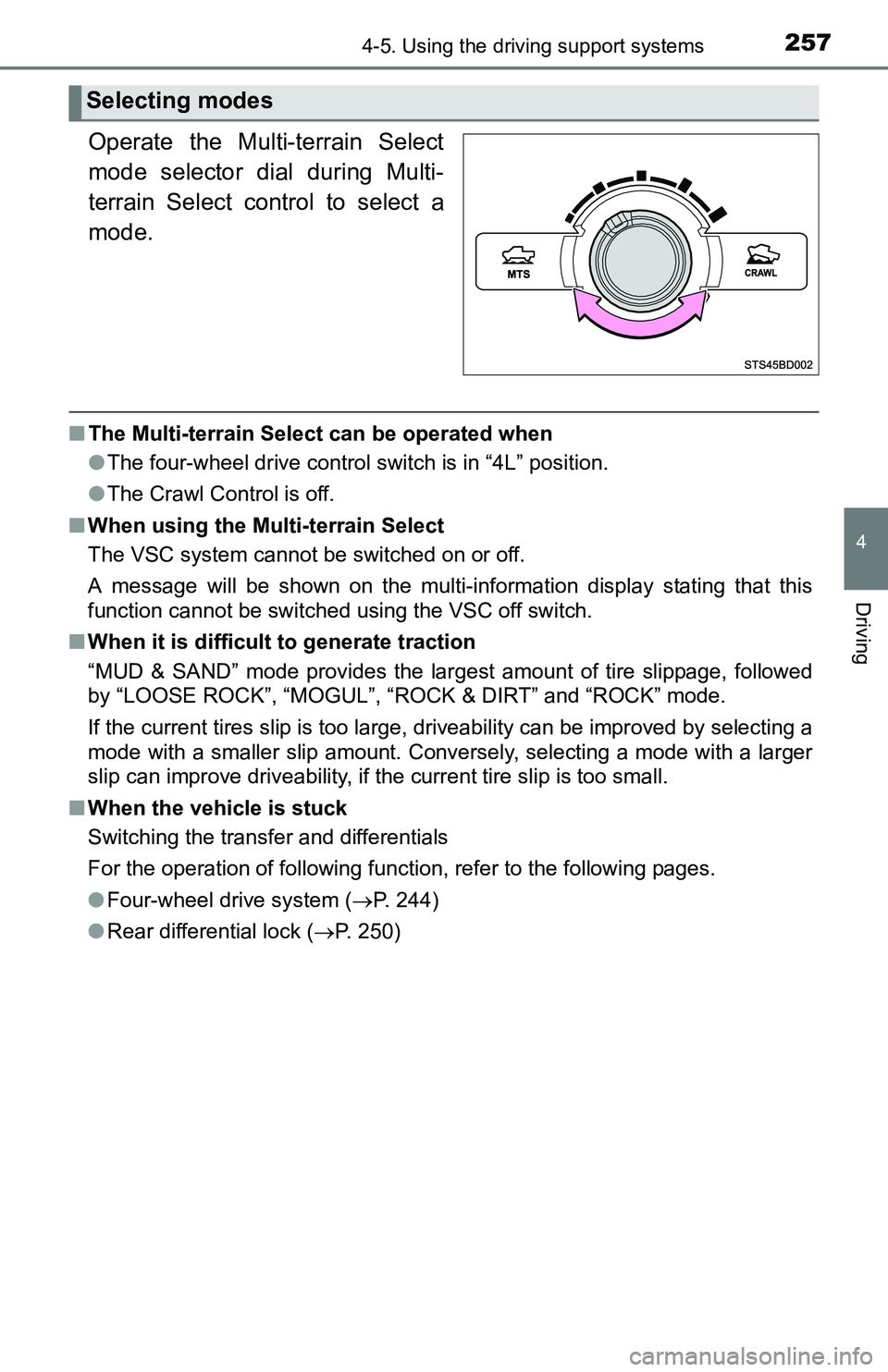
2574-5. Using the driving support systems
4
Driving
Operate the Multi-terrain Select
mode selector dial during Multi-
terrain Select control to select a
mode.
■The Multi-terrain Select can be operated when
●The four-wheel drive control switch is in “4L” position.
●The Crawl Control is off.
■When using the Multi-terrain Select
The VSC system cannot be switched on or off.
A message will be shown on the multi-information display stating that this
function cannot be switched using the VSC off switch.
■When it is difficult to generate traction
“MUD & SAND” mode provides the largest amount of tire slippage, followed
by “LOOSE ROCK”, “MOGUL”, “ROCK & DIRT” and “ROCK” mode.
If the current tires slip is too large, driveability can be improved by selecting a
mode with a smaller slip amount. Conversely, selecting a mode with a larger
slip can improve driveability, if the current tire slip is too small.
■When the vehicle is stuck
Switching the transfer and differentials
For the operation of following function, refer to the following pages.
●Four-wheel drive system (P. 244)
●Rear differential lock (P. 250)
Selecting modes